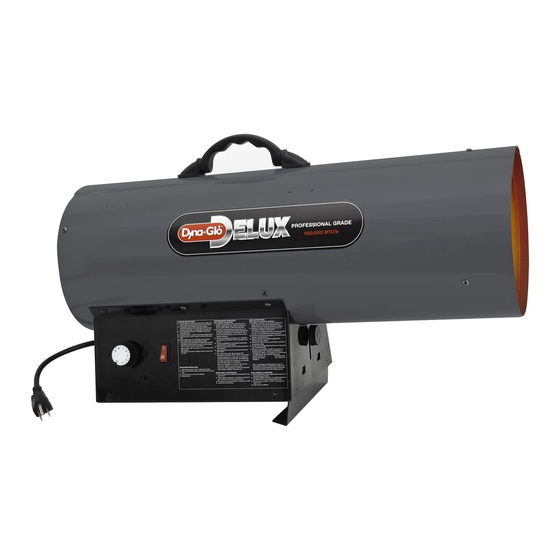Dyna-Glo RMC-FA150NGDGD Mode d'emploi et manuel des pièces détachées - Page 3
Parcourez en ligne ou téléchargez le pdf Mode d'emploi et manuel des pièces détachées pour {nom_de_la_catégorie} Dyna-Glo RMC-FA150NGDGD. Dyna-Glo RMC-FA150NGDGD 11 pages. Natural gas construction heater
Également pour Dyna-Glo RMC-FA150NGDGD : Mode d'emploi et manuel des pièces détachées (10 pages)

Dyna-Glo Delux Operating Instructions and Parts Manual
Model RMC-FA150NGDGD
regulator/hose assembly listed on the
parts list prior to using this heater.
– Gas supply connections should be
checked using a 50/50 solution of
liquid dish soap and never use a flame
to check for gas leaks.
– The electrical connection & grounding
must comply with National Electrical
Code. ANSI/NFPA 70 or in Canada CSA
C22.1, Canadian Electrical Code, Part 1.
Use only a properly grounded three (3)
prong receptacle.
– Do not restrict inlet or outlet by any
means. The flow of combustion and
ventilation air is not to be obstructed.
– This heater should not be directed
toward any propane-gas container
within 20 ft (6M). The heater must be
located at least 6 ft. (1.83 m) in the
U.S.; or (ii) 10 ft. (3 m) in Canada, from
any propane gas container.
– The propane cylinder supply system
must be arranged to provide for
vapour withdrawal from the operating
cylinder.
– This heater is not to be used with
Clean
Heated
Air Out
(Front)
Combustion Chamber
Air Combustion
external thermostats, timers or other
and Heating
devices that control or alter electrical
Figure 2 – Cross Section Operational View
supply to the heater.
For Technical Support or Troubleshooting, Call: 1-877-447-4768, 8:30 am - 4:30 pm CST
– Heater must be placed on a flat stable
surface. Do not position the heater
at any other angle than the intended
design position. Certain models can
change the up and down tilt angle by
loosening the "height control screw"
and moving the "height controller",
then retightening the "height control
screw".
– This heater is not designed to thaw
ground surfaces.
– Installation of this Appliance at
altitudes above 2000 ft. (610 m) shall
be in accordance with local codes,
or in the absence of local codes the,
National Fuel Gas Code, ANSI Z223.1
/ NFPA 54, or National Standard of
Canada, Natural Gas and Propane
Installation Code, CSA B149.1.
Nozzle
Motor
Ignitor
Fan
On/Off Switch
Solenoid Valve
Regulator
Spark Module (Spark Ignitor)
PCB Control
Fuel
3
NEVER LEAVE THE HEATER
UNATTENDED WHILE BURNING!
Principals of Operation
FUEL SYSTEM
The pipe runs from the gas supply to
the heater itself. After the gas runs
through the pipe, it passes through
the solenoid valve and out the nozzle
into the combustion chamber.
AIR SYSTEM
The internal motor turns the fan, which
pushes air around and through the
combustion chamber. Here the air is
heated and provides a constant stream
of warmth.
IGNITION SYSTEM
The spark module sends voltage to the
ignitor. The ignitor ignites the fuel and
air mixture.
SAFETY CONTROL SYSTEM
This system shuts the heater down if
the flame is extinguished. The fan and
motor will continue to operate, but
there will not be any heat.
TEMPERATURE CONTROL SYSTEM
A built-in thermostat allows the heater
to turn on and off to maintain a
consistent temperature.
THE NATURAL GAS SUPPLY
The user of this heater must provide
the natural gas supply and all fittings to
properly install the heater.
The natural gas supply should be able
to provide a minimum of 150 cubic feet
of gas per hour for each heater being
used. Consult with your natural gas
Power Cord
supplier for the proper sizing of all gas
lines. You must regulate the natural
gas supply down from a minimum of 5
inches of water column to a maximum
of 1/2 PSI.
Be sure to research and follow all local
ordinances and codes. In the absence of
www.ghpgroupinc.com
PROFESSIONAL GRADE
